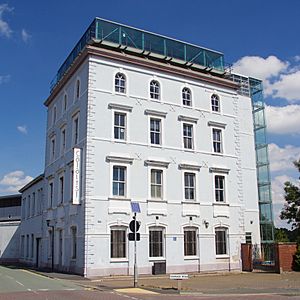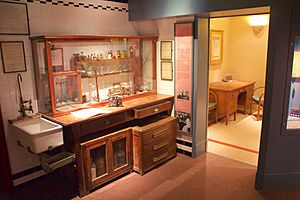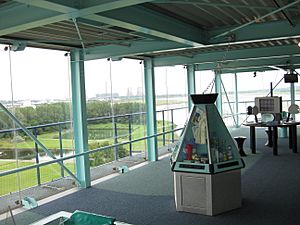Catalyst Science Discovery Centre facts for kids

Catalyst Science Discovery Centre and Museum.
|
|
| Former name | Museum of the Chemical Industry |
|---|---|
| Established | 1987 |
| Location | Widnes, Halton, England |
| Type | Science museum |
| Accreditation | Arts Council England |
| Visitors | 30,000 |
The Catalyst Science Discovery Centre and Museum is a super fun science museum in Widnes, England. It's a great place to explore science and technology! The museum has lots of cool things to see and do. You can try out interactive exhibits, see old-time scenes, visit an observatory, watch live science shows, and join family workshops. It's right next to Spike Island, a big park with woods, wetlands, and walking paths. The museum building itself is very old and interesting.
The museum is inside a building called Tower Building. It was built around 1860 by John Hutchinson for his chemical business. The museum also keeps a huge collection of old papers and photos about the chemical industry. This includes documents and research from a big company called ICI.
Contents
Discovering Catalyst: A Science Adventure
Catalyst is located in Widnes, right next to Spike Island. The museum is in an old four-story building with some newer parts added on. This building, originally called the Tower Building, was built around 1860. It was first used by John Hutchinson for his chemical business. Later, it became the main office for the Gossage soap company. This company was once the biggest soap maker in the world! Widnes was a very important center for making chemicals for about 170 years.
The idea for the museum started in 1982. There was a temporary exhibition to celebrate a big chemistry group called the Society of Chemical Industry. Local leaders and chemical companies decided to make it a permanent museum. They checked if there were enough old items and a good place to set up a museum about the chemical industry. A small display was first put in the old Widnes Town Hall. It showed local history and the chemical industry.
The museum officially opened in 1987. It was first called "The Museum of the Chemical Industry." It was said to be the first museum in the world just for the chemical industry! In 1989, a cool glass lift and a glass observation deck were added to the top of the building. In 1991, new interactive exhibits were added. Later, in 1994–95, an education center was built. The museum wanted to help people understand more about industry and science.
What You Can Do at Catalyst
Catalyst is a hands-on science and technology museum. It has more than 80 interactive exhibits! You can also enjoy multimedia shows and see recreated historical scenes. These bring science, technology, and engineering to life. Besides the displays, there's a theatre for live science shows. On the top floor, there's an observatory. From there, you get amazing views of the River Mersey, Spike Island, and the Mersey Gateway Bridge. During school holidays, the museum offers fun family workshops. There's also a cafe if you get hungry.
The museum's collection includes everything from tiny test tubes to a giant 20-ton metal container. You can see old lab equipment and chemical samples. The museum mainly focuses on the chemical industries that used salt in the Merseyside area. But it also covers other chemical industries nearby. Catalyst also collects items about local social history. This helps show how the chemical industry affected people's lives in Widnes and Runcorn.
The museum is right next to Spike Island, which is a fantastic park. It has walking and cycling paths, the Sankey Canal, woodlands, and wetlands. You can see the River Mersey and the Mersey Gateway Bridge. It's a great spot for birdwatching or fishing. The park also has picnic tables, a sports pitch, and a children's play area. You can even see old industrial sites there.
About 30,000 people visit Catalyst every year. Many school groups come to the museum too. Catalyst has special programs that connect to what kids learn in school. The museum has won several important awards, including the famous Gulbenkian award.
Exploring the Archives
The museum keeps a large collection of historical documents about the chemical industry. This collection started in 1982. It has almost 8,000 different items, including objects, old papers, and photographs. If you count all the individual items, it's closer to 10,000! If you add the research files from the ICI General Chemicals Group, the collection has over 35,000 items. You can find more details about these collections on the Catalyst website.
The archives include company papers, product brochures, and other old documents. There are also many photographs showing products, how things were made, company history, and local life. The collection also has photos from the Teesside Bridge & Engineering Company. They also have old films from the Brunner Mond company. The museum's library has many old books and magazines. These include the Journal for the Society of Chemical Industry and the Imperial Chemical Industries magazine. There are also many books about chemistry, industry, and the local area.
The museum also has a map collection. It includes maps of Widnes and Runcorn from the Ordnance Survey. There are also maps showing things like the sewer system in Halton. You can see old plans for a railway and plans for the Widnes-Runcorn Transporter Bridge. The museum also has a fine art collection. This includes paintings of local chemical makers and pictures of old factories. There are also bronze statues and plaques.
See also
- List of museums in Cheshire
- Listed buildings in Widnes
- List of science centers in Europe






